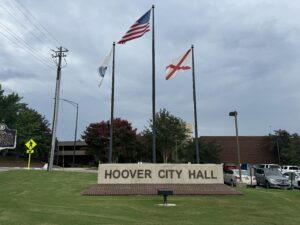Dan Sutter: The NCAA cartel is collapsing
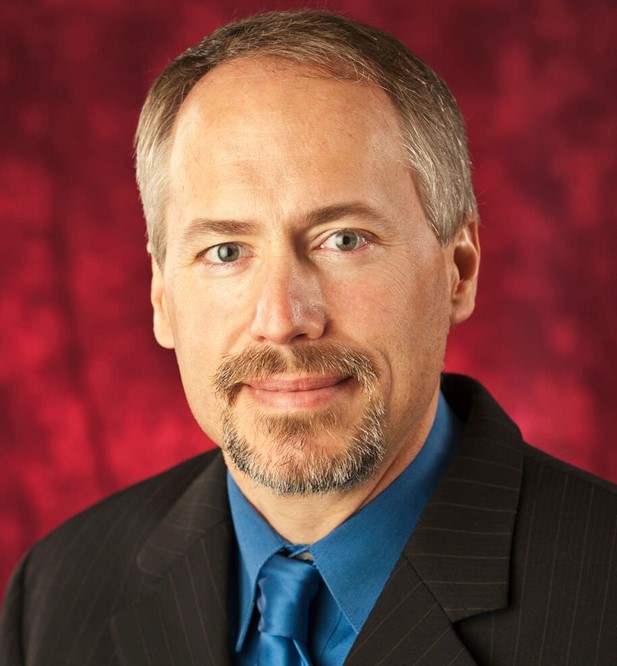
The unanimous U.S. Supreme Court decision in NCAA v. Alston portends change for college sports. This case involves education-related benefits and is separate from cases about athletes’ “name, image, and likeness.” The NCAA’s 100-year effort to not pay student-athletes is close to ending. Justice Neil Gorsuch authored the opinion, but Justice Brett Kavanaugh’s concurring opinion has garnered more attention. Justice Kavanaugh wrote, “The NCAA’s business model would be flatly illegal in almost any other industry in America. … The NCAA is not above the law.” He seems to accept that the NCAA is a cartel expounded by economists like the late Robert Tollison of Clemson University. A cartel in economics is a group of businesses (or universities) acting to restrict competition. The best-known cartel is OPEC, which tries to keep the price of oil high to increase oil-producing nations’ profits. Businesses also benefit from paying less for labor. The amateur status of college athletes fixes compensation at the value of a scholarship and related benefits. The NCAA began by enforcing common rules for college football to reduce the level of violence. Once college football began earning significant revenues, schools offered inducements to top players. The NCAA barred such compensation of athletes, although Professor Tollison contended that it became an effective cartel only once it could discipline violators through probation. The NCAA cartel illustrates via contrast the normal operation of labor markets. Economics shows that businesses can afford to pay workers up to the value their work creates. Competition between businesses for workers bids wages up to this amount. Colleges are not-for-profit businesses, but the same principle of revenue creation should still apply. If top recruits are worth $1 million and one school refuses to pay this full value, others will lure its recruits by offering payment. NCAA punishment halts the normal competition for productive players. Sports often feature such cartel behavior. Leagues generate enormous revenues, making stars worth millions per year. Yet most players’ best alternative work option outside of sports might pay $50,000 a year. Teams can potentially keep salaries way below market levels by not bidding for players. Major league baseball accomplished this via the reserve clause until the advent of free agency. How will the looming pay-for-play affect college football? I see three relevant considerations. First, can colleges afford to pay players, given that many athletics programs lose money on paper? I suspect so. Colleges are not businesses delivering profits to owners, and athletic departments are not stand-alone entities. Economics predicts that non-profit organizations will convert excess revenue (the $100 million-plus top athletic departments generate annually) into excessive costs. Excessive costs can be trimmed to allow compensation. A second issue is competitive balance. Schools generating the most revenue will be able to pay more for players. Large market teams similarly threaten competitive balance in pro sports, and salary caps and revenue sharing try to maintain balance. The rules on compensation will determine the threat to competitive balance. Payments to players may well reduce Alabama’s current domination of college football. Not paying individual players allows the Crimson Tide, given the juggernaut Coach Nick Saban has created, to offer a great deal to many five-star recruits each year: a proven path to the NFL and likely a national championship. Rivals need to offer extra compensation to be as attractive to recruits as Alabama. The third issue involves sustaining fan interest. Many fans strongly prefer college to pro football despite the NFL’s higher skill level. Economists have no skill in psychoanalyzing consumers. I can offer an observation. Improved coaching, strength training, and nutrition allow players today to realize more of their athletic potential. This significant element of professionalization has not reduced interest in college sports. Competition drives efficiency in our economy. The NCAA cartel has restricted competition. As college sports ventures into unfamiliar territory, remember that competition usually makes us better off. Daniel Sutter is the Charles G. Koch Professor of Economics with the Manuel H. Johnson Center for Political Economy at Troy University and host of Econversations on TrojanVision. The opinions expressed in this column are the author’s and do not necessarily reflect the views of Troy University.
Nick Saban tapes message encouraging Alabamians to get vaccinated

Alabama football coach Nick Saban and other sports figures have taped a public service announcement encouraging Alabamians to get the COVID-19 vaccine. The Alabama Department of Public Health says Saban and others, including former NBA star Charles Barkley, participated in the PSA saying vaccinations are the way to make sure sports stadiums are filled and “loud again” this fall. “College football fans and players both want full stadiums this fall. Let’s make sure we can safely make this happen by getting vaccinated. Please get your COVID-19 vaccine,” Saban says in the spot, according to a script provided to The Associated Press. “We want Bryant-Denny Stadium loud again this coming season and Roll Tide!” The public service announcement is expected to be released next week. It comes as state health officials are looking for ways to boost lagging vaccination rates and persuade people to sign up for shots. Less than 25% of Alabamians have been fully vaccinated, which ranks last nationally, according to the Centers for Disease Control and Prevention. The public service announcement is part of a campaign by the Alabama Department of Public Health to address vaccine hesitancy, State Health Officer Scott Harris said. University of Alabama athletic director Greg Byrne has said the school intends to allow 100% capacity next season for the defending national champions. Byrne posted a tweet saying he appreciated “Coach Saban’s leadership encouraging vaccination.” Republished with the permission of the Associated Press.
Colorado’s Aerospace Alley prepares for Space Command move
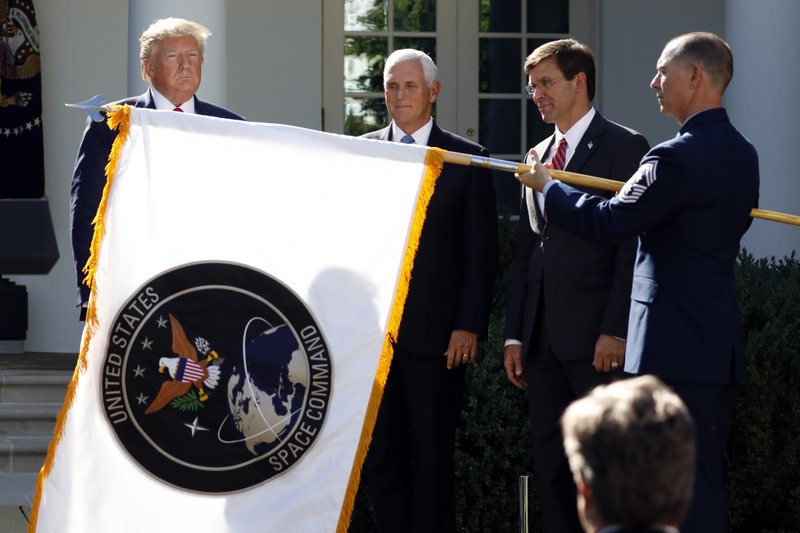
When Kathy Boe heard the news in January that President Donald Trump was moving the headquarters of U.S. Space Command from Colorado Springs to Huntsville, Alabama, she understood why Trump was making the move — even though she expected Colorado Springs to be the frontrunner in the race. “We kind of knew they were our biggest competitor all along,” said Boe, the founder and CEO of Colorado Springs-based aerospace company Boecore. Boe started her company in her Colorado Springs basement 21 years ago. The business, which designs software for military space and missile defense projects, now employs 275 people in the city.Since that time, Boe’s business has also expanded to other locations, including Huntsville. The Boecore office there opened 12 years ago, and Boe said there has been plenty of private and public sector military work going on between the two cities for decades. Boe has even advocated for the Colorado Springs Airport to add a direct flight to Huntsville. The Army’s Redstone Arsenal, near Huntsville, is host to a number of federal military installations, including the Missile Defense Agency, NASA’s Marshall Space Flight Center and Army Space and Missile Defense Command. After Trump’s decision, Alabama Governor Kay Ivey called the region “the most natural choice” for U.S. Space Command. Yet, Colorado’s top elected representatives, including the state’s entire congressional delegation, cried foul. They argued the Defense Department’s space assets in Colorado focused on operating military satellites are a far more logical fit for the work done through the Space Command mission. Plus, they pointed out, Peterson Air Force base has already been effectively hosting the command since it was re-established in 2019 and moving it would lead to a costly duplication of resources. Colorado’s political leaders saw Trump’s move as an overtly partisan one, meant to pacify two Republican senators ahead of a heated vote on whether to convict the former President on impeachment charges. In February, the Defense Department — operating under new President Joe Biden — announced it would investigate the circumstances behind Trump’s Space Command decision. News of the investigation left Colorado politicians cheering. Governor Jared Polis said the investigation could help “restore integrity” to the flawed and “fiscally irresponsible” decision. Senators Michael Bennet And John Hickenlooper put out a joint statement that said moving the command to Alabama would jeopardize national security. Gov. Ivey in Alabama quickly welcomed the official review of the Huntsville selection, saying the location was “chosen based on merit.” Journalist Lee Roop covers Alabama’s aerospace industry for the statewide news service AL.com. He said despite Colorado’s enthusiasm in the wake of the investigation, people in Huntsville are largely convinced the decision will stand. “Our (University of Alabama) football coach down here, Nick Saban, he always says ‘Trust the process and you’ll get where you want to go,’” Roop said. “So, there’s a process and they felt confident about the process.” The earliest Redstone Arsenal would take over hosting Space Command from Colorado Springs would be in 2026. That time would allow Redstone to build the necessary facilities to house the Command. Rep. Doug Lamborn said in a commentary for Defense News that the Department of Defense has spent over $350 million in the last 15 years on “space-specific infrastructure” in Colorado. He said building the infrastructure for a new headquarters in Alabama would be “expensive” and that building similar headquarters around the country have cost the federal government hundreds of millions of dollars. Roop said he expects the newly announced investigation into the decision will delay the timing of Space Command’s move to Alabama even further. More than 18 months ago, the Wings Over The Rockies Air and Space Museum started a campaign to popularize the term “Aerospace Alley” in reference to Colorado’s burgeoning aerospace industry. The campaign touts Colorado’s concentration of a private aerospace workforce, which they say is the highest in the nation: 500 aerospace companies. The majority of those companies employ 10 or fewer people, according to retired Air Force Maj. Gen. John Barry, the President and CEO of Wings Over The Rockies. “It kind of reminds me of what Silicon Valley must have been like when the industry started out back there with small companies and people working in garages and things like that,” Barry said. The Aerospace Alley campaign is largely focused on workforce development — to attract and educate young aerospace talent. Barry said that even if U.S. Space Command does ultimately move to Alabama, much of the command’s operations will still be run from the Centennial State. “Will it hurt? Yeah, it’ll be a little bit of a stigma,” Barry said. “But, will it be able to prevent us from being able to continue with the aspect of trying to put Colorado as maybe the number one aerospace state in the nation? I don’t think so.” That’s also the case for Alabama. Roop said the rest of the country doesn’t often realize how much aerospace work is already done in the state. “People here really want the command to come, and we’re very excited about it. But, you know, it’ll be OK. It’ll be OK any way it turns out,” Roop said. Republished with the permission of the Associated Press.
Sacrifice and stress: How players handled season of COVID-19
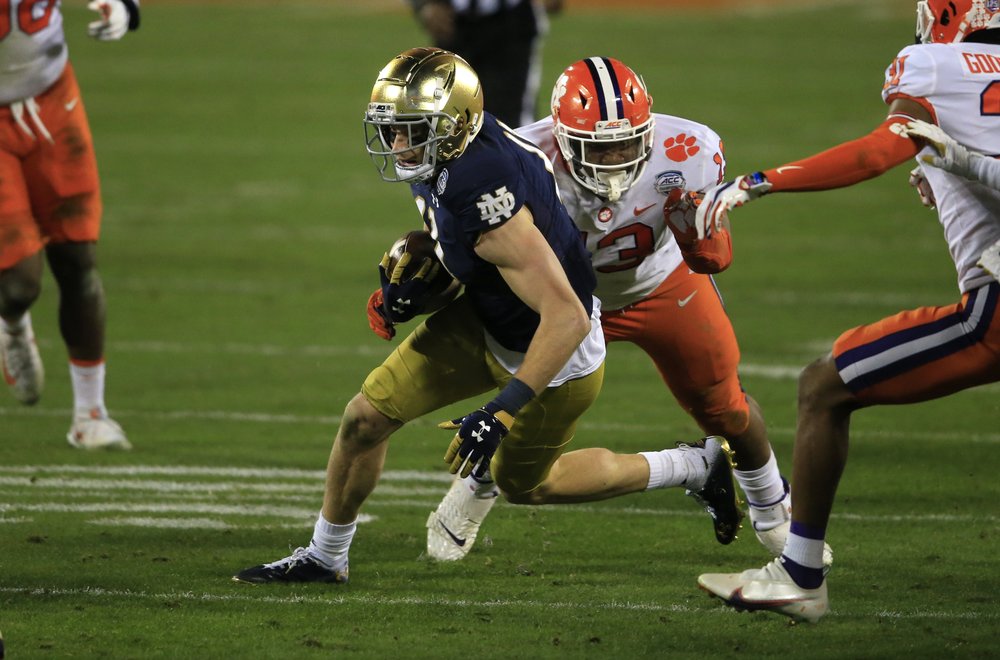
The Saturday night after winning an afternoon home game is one of the best times to be a college football player. Family and loved ones usually await with congratulatory hugs. Then there is a nice dinner and maybe more celebrating with teammates and friends. Few things get a college town hopping like a football victory. But not this season. “I’d pretty much go home, lay on my couch, watch (video) cut-ups of the game like two or three times. Probably go pick up some food,” Notre Dame offensive tackle Liam Eichenberg said. To play through a pandemic, players had to sacrifice much of their lives away from the game, along with some of the best aspects of being part of a team. To reach the playoff, No. 1 Alabama, No. 2 Clemson, No. 3 Ohio State, and No. 4 Notre Dame had to go a combined 37-2 on the field and keep the coronavirus at bay. “It’s been incredibly challenging,” Clemson coach Dabo Swinney said. “I just tell them, don’t give up what they want most for what they may want at the moment. It’s just really that simple. And the teams that do this the best and manage this the best, that’s who’s going to finish the best.” Doing so required lots of COVID-19 testing, and the anxiety that comes with knowing the next test could be the one that puts a season on hold, and little time spent with anyone outside the team. Even when the players were together, there were obstacles — both literal and figurative — to bonding with teammates. “Eating together as a team, we do it with a glass divider between us,” Notre Dame receiver Ben Skowronek said Monday during media Zoom sessions for the CFP. “I miss those meals and just getting to know people in the locker room. All that stuff.” Another oddity brought on by the pandemic: Four days before the New Year’s Day semifinals, the playoff participants were still on their respective campuses. Alabama faces Notre Dame in the relocated Rose Bowl at the home of the Dallas Cowboys in Arlington, Texas. Clemson and Ohio State meet at the Sugar Bowl in New Orleans in a rematch of last year’s thrilling semifinal. Typically, teams arrive at the site of their semifinal about five or six days in advance. The bulk of the preparation for the game has already been done. At the host city, there are media availabilities, practices, and a walkthrough or two at the stadium. There are activities away from the field, outings, and meals. Plus, some unsupervised time for the players. “Going to a bowl site is always what you work for,” Clemson linebacker Baylon Spector said. “It’s very fun. You get to do a lot of different things.” As for this week, Spector said: “Tonight, we got bingo night. We’re enjoying it as much as we can.” The teams will arrive at the host cities on Wednesday. Alabama and Clemson gave players some freedom to be with family on Christmas and other breaks this season, but with strict orders to mask up and keep their distance, even with loved ones. Notre Dame and Ohio State were more cautious, keeping their players on campus over the recent holiday weekend. There is still more COVID-19 testing to be done, and each team has learned through experience that nothing is guaranteed this season. “It was really stressful, but the main thing was trying to keep a level mind and do the things that we needed to do in order to succeed,” Alabama linebacker Dylan Moses said. Alabama had one game postponed because of an opponent’s COVID-19 outbreak, and it played the Iron Bowl against Auburn without coach Nick Saban after he tested positive. Notre Dame had a virus outbreak pause its season for about two weeks in late September. Clemson star Trevor Lawrence missed two games, including the Tigers’ regular-season loss to Notre Dame, after contracting COVID-19. Ohio State played only six games after the Big Ten started in late October, losing two games because of opponents’ COVID-19 issues and one because of their own. “What stood out to me the most, what I find to be the hard thing is how one day you can practice and the next day you’re out a couple weeks because of COVID,” said Ohio State All-American offensive lineman Wyatt Davis, who has not contracted the virus. “It’s just a day-to-day thing. Holding guys to a standard that you can’t go out and hang out with people. You can’t go see your family.” Josh Myers, Davis’ friend and linemate, did contract COVID-19. Myers said 10 days in isolation was terrible, mostly because of the boredom and inactivity. He said he has had no lingering effects of the virus. Tigers linebacker Mike Jones said winning made the restrictions easier to live with and Clemson did a good job of implementing and enforcing protocols. After a while it felt normal, but it was anything but the usual college experience. “You know it’s kind of weird not being able to hang out with your friends all the time,” Jones said. “Not being able to see your family after the game. Not going home during your bye week because you don’t want to risk it. (No) celebrating after wins and stuff like that. Being with your buddies on the bus to away games. “It’s been a lot. We’ve all had these trials and managed to get through them.” Republished with the permission of the Associated Press.
Tide’s Nick Saban tests positive for virus, will miss Iron Bowl
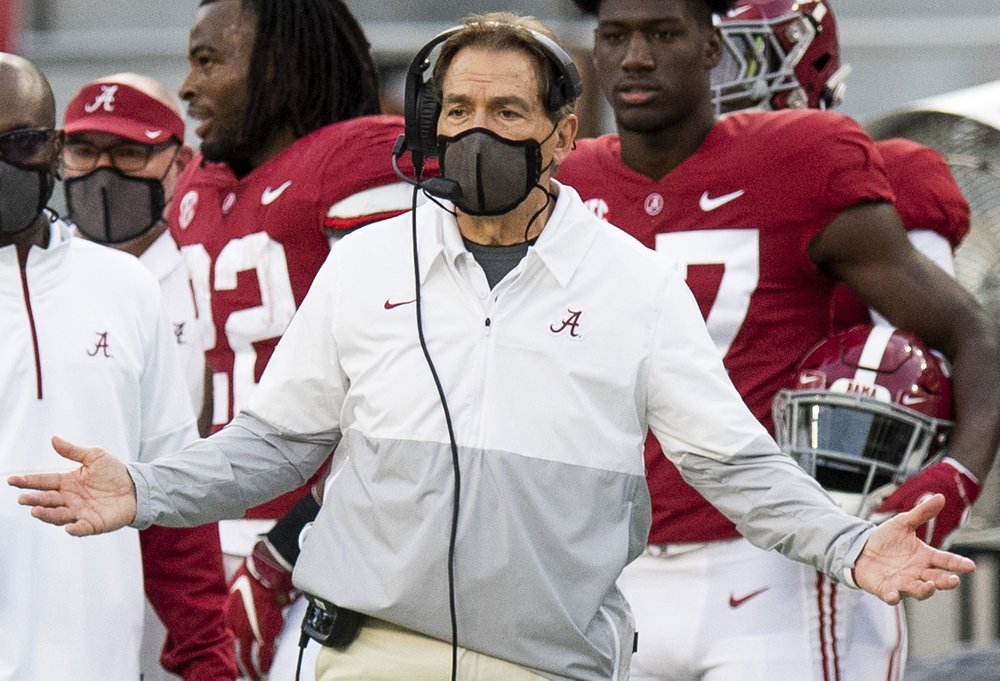
The Iron Bowl will be without its biggest star. Nick Saban, the coach at No. 1 Alabama, tested positive for COVID-19 Wednesday as the Crimson Tide prepares for its annual showdown with No. 22 Auburn. Since he was experiencing mild symptoms, it appears there won’t be a false positive reprieve for Saban like there was last month before another huge game against Georgia. “He has very mild symptoms, so this test will not be categorized as a potential false positive,” team physician Dr. Jimmy Robinson and head trainer Jeff Allen said in a joint statement. “He will follow all appropriate guidelines and isolate at home.” The Crimson Tide is set to face its biggest rival Saturday at Bryant-Denny Stadium without the 69-year-old, six-time national champion coach. Offensive coordinator Steve Sarkisian, a former head coach at USC and Washington, will oversee preparations and lead the team on game day. Saban said he has had a runny nose, but no major symptoms. When he tested positive ahead of the game with Georgia, he didn’t have any symptoms. Saban ended up being cleared to coach in that game after subsequent tests leading up to the game came back negative. This time appears different. “It was a PCR test which was different than the false positive that I had before,” Saban said on the Southeastern Conference coaches’ teleconference. “I don’t really have any cardinal signs of the virus right now. I don’t have a fever, no loss of taste or smell, no fatigue, no muscle aches. … I’m the only person in the whole organization who tested positive this round.” Saban will still run meetings and monitor practice via Zoom at home like he did ahead of the Georgia game. Sarkisian will still call offensive plays during the game, but Saban said other details were still to be ironed out. “Last time I did this for three days, I absolutely did everything from home that I did in the office,” Saban said. “I just did it on Zoom.” Saban said he has no idea how he got the virus, and it wasn’t immediately clear if anybody else within the program will be affected because of close contact. Saban believes that’s unlikely “based on how we manage things internally in the building.” “I’m around nobody. I mean, I go home and I go to the office,” Saban said. “I have no idea. Now, there are some people in and out of our house on occasion, but I have no idea how this happened. We really practice social tracing, social distancing, all the things that we need to do to be safe. “We’re always six feet apart in meetings,” he said. “We have staff meetings in large rooms. Everyone is required and we all wear masks. Players all wear masks in meetings.” Auburn coach Gus Malzahn figures facing Alabama without Saban on the opposite sideline will be the latest bizarre aspect to “a really weird year.” “I hope his symptoms are not severe or anything. Hope he makes a speedy recovery,” Malzahn said. “It’s going to be a really weird deal playing the Iron Bowl without Nick being there. Just another sign of a very unusual season.” Saban is one SEC regular-season victory away from tying ex-Florida and South Carolina coach Steve Spurrier for second in the history of the conference. Spurrier’s 131 SEC wins trail only Alabama legend Bear Bryant (159). While Alabama was hopeful the Tide will still be able to play on Saturday, two more Top 25 teams called off games this weekend: No. 7 Cincinnati won’t play at Temple because both teams are dealing with COVID-19 issues and No. 14 Oklahoma postponed its game at West Virginia due to recent positive tests and contact tracing. That game is now scheduled for Dec. 12. The American Athletic Conference said the Cincinnati-Temple game could not be made up on Dec. 5, even though both teams have an open date, because league protocols “would not allow for a sufficient number of players to be available for competition on that day.” The unbeaten and conference-leading Bearcats’ next game is scheduled for Dec. 12 at No. 24 Tulsa, which had its Saturday game against Houston postponed because the Cougars have been hit by the virus. Tulsa is also unbeaten in conference play and with a victory next week against Navy it would clinch a spot in the AAC championship — against Cincinnati. With Thursday’s Colorado State game at Air Force also called off, 13 games this week have been postponed or canceled across major college football. That raises the total for this month alone to 56 games directly impacted by COVID-19 issues for at least one of the teams. Republished with the permission of the Associated Press.
Alabama officials trying to combat virus vaccine resistance

With a possible vaccine for COVID-19 still more than two months away, Alabama health officials said Thursday that they already are working to combat the reluctance among some to accept an immunization that’s become politically divisive. Small amounts of vaccines currently in trials could begin arriving by the end of the year, and a communications program to overcome hesitancy by some to receive the shot is a key part of the planning, Dr. Scott Harris said at a briefing on the program. Treatments for the new coronavirus have a “political dimension” that, when combined with longstanding resistance to vaccines and historical distrust of public health by groups including Black people, will present a challenge to getting as many people as possible to accept vaccination, he said. The Department of Public Health, which Harris heads, is in contact with medical practices and groups, faith leaders, local officials, and legislators in hopes they can help pave the way for acceptance, he said. “We have a lot of our staff interacting with different groups,” he said. Even with the expected reluctance among some to get vaccinated, initial supplies will be small and the first doses likely will go to older people, those with health problems that make them more susceptible to the disease, and health care staff working in places like nursing homes, he said. “I don’t think there’s any question that vaccine will be a scarce resource,” Harris said. The vaccine will be free to everyone but likely not widely available until next spring, he said. Alabama has recorded about 170,000 confirmed cases of COVID-19, caused by the new coronavirus, and about 2,760 people have died. Caseloads and hospitalizations that fell after the state required face masks in public haven’t gone up as badly as feared since schools began, yet they’ve also not decreased. “We believe we’ve sort of leveled out,” said Harris, although some statistics have shown a slight worsening in recent days. The state got a jolt Wednesday when the University of Alabama said football coach Nick Saban — who has actively supported face masks and other pandemic safety precautions — had tested positive for COVID-19. Still, health officials said masks, social distancing, and hand washing are the best prevention for the illness and will remain important until vaccines are widely available. The state’s mask regulation continues through Nov. 8, and Gov. Kay Ivey could extend it again at that time. Republished with the permission of the Associated Press.
Virus wreaking havoc on SEC with Nick Saban now testing positive
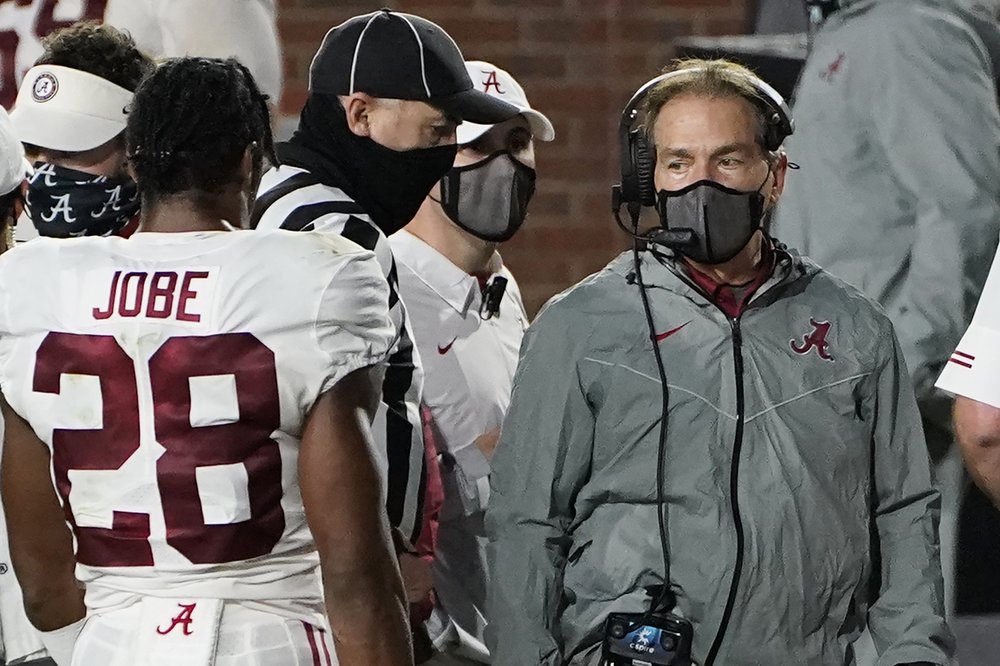
The Southeastern Conference had to postpone two games in the last three days because of positive COVID-19 tests, and now Alabama coach Nick Saban and his athletic director have tested positive for the virus ahead of the league’s biggest regular-season showdown. Saban said in a statement Wednesday that he’ll be working from home with offensive coordinator Steve Sarkisian overseeing the second-ranked Crimson Tide’s preparations to play No. 3 Georgia on Saturday night. “At this time, I do not have any symptoms relative to COVID, and I have taken another PCR test to confirm my diagnosis,” said Saban, whose AD Greg Byrne also tested positive. No. 10 Florida’s game against defending national champion LSU was postponed Wednesday to tentatively Dec. 12 after the SEC postponed Missouri-Vanderbilt on Monday. More positive tests could derail other games after the league waited until the end of September to kick off the season due to the coronavirus pandemic. The Gators started testing daily Sunday and paused activities Tuesday after 19 positives with about a dozen more quarantined through contact tracing. Athletic director Scott Stricklin said they had 18 positives among scholarship players plus three walk-ons for a total of 21. That left the Gators with less than 50 scholarship players available. Stricklin said it can sneak up on a team in a hurry and the key is hitting the brake. “The SEC schedule was set up with something with an event like this in mind,” Stricklin said. “As much as we want to give our kids the opportunity to compete, we understand this isn’t a normal year and we’re going to have to have the ability to adapt to unusual circumstances such as this.” Florida is hoping those numbers don’t rise further, not that coach Dan Mullen wanted to speculate on the tests. “We’re certainly hoping and everybody that we’ve worked for getting these tests back before we conduct any team activity to make sure that we’re keeping everyone as safe as possible,” Mullen said. Vanderbilt coach Derek Mason is going through a similar situation. He said his Commodores (0-3) are a “shell” after he had an estimated group of players in the “high 40s” available for practice Wednesday with a couple of coaches involved in this outbreak. Vanderbilt has an open date Oct. 24 and won’t play again until hosting Mississippi on Oct. 31. Mason also noted this issue isn’t a Vanderbilt problem, noting how the NFL’s Tennessee Titans were down for 16 days while testing players daily. Every coach will be watching to see how many players are available the rest of this season. “For college football, it’s a red flag or something that we really have to be aware of in terms of understanding that we don’t control everything,” Mason said. Ole Miss coach Lane Kiffin said his Rebels are dealing with their first COVID-19 issue of the season. He called it a “big challenge” for a team already banged up after a very physical game in a 63-48 loss to No. 2 Alabama. His Rebels (1-2) are scheduled to visit Arkansas (1-2) on Saturday after their 63-48 loss to No. 2 Alabama. Kiffin wouldn’t be more specific. “Just like injuries, we’re not going to get into details on that,” Kiffin said. “We’re just trying to manage it the best we can. Ole Miss, like Vanderbilt and now Florida, could quickly find the game schedule changing depending on the next batch of test results. “I hope not,” Kiffin said of a potential postponement. “If we were to play today, we could play. So hopefully it stays that way.” Tennessee coach Jeremy Pruitt said Monday that he had his entire team together for just the third straight week after testing and tracing had left players sidelined in isolation or quarantine. Georgia coach Kirby Smart said he knows his team is one exposure away from having an issue. “We’ve been very fortunate so far, but we don’t have our test results back even from this week,” Smart said Tuesday. Vanderbilt already was hit hard by having so many players opt-out of this season because of the pandemic. The number has been reported as six Commodores opting out, including the kicker and four offensive linemen. Mason said Wednesday that total is closer to 10, which would be an SEC-high. The numbers coaches will be monitoring most closely will be how many scholarship players are available. To play, the SEC requires at least 53 on game days. Vanderbilt had only 56 last weekend in a 41-7 loss to South Carolina. Having an open date should help Vanderbilt suit up enough players to play Oct. 31. Mason said Vanderbilt has anyone who tests positive go into isolation for 10 days, followed by cardiac screening and then a cardiac MRI adding another three days to the process. Players also need at least three or four days of conditioning to play. Timing is critical depending on the day of the week a positive test or tracing result returns. “Every time you’re taking a test,” Mason said, “you’re crossing your fingers … you don’t have anybody in harm’s way.” Republished with the permission of the Associated Press.
Nick Saban, Alabama players hold protest march on campus

The group marched the short distance Monday on the school’s campus from the Mal M. Moore Athletic Facility to Foster Auditorium.
CARES Act funds used to air COVID ads in Alabama

The ads will begin airing as the state sees a dramatic increase in the number of confirmed COVID-19 cases.
Daniel Sutter: Men, women, marriage and earnings

The #metoo movement has brought renewed focus on gender equity questions. Economics examines the pay gap between men and women, and a recent analysis from the Federal Reserve Bank of St. Louis links this gap to marriage, creating a puzzle for economics. The gender pay gap is large: among workers with at least a high school diploma between ages 45 to 54, men earn almost 50 percent more than women, roughly $75,000 versus $50,000 annually. Is this evidence of discrimination against women we could address through comparable worth pay legislation? Perhaps, but first let’s dig deeper into the issue. Labor economics explains wages and salaries based on productivity, or the extra output that a worker helps a business produce. Firms can afford to pay workers the value of this product and still make an adequate profit. Competition among firms to attract and retain good workers should drive salaries up to this level. If Alabama underpaid Nick Saban, other universities would happily compensate him fairly. Salary differences should then depend on differences in productivity. Economists would want to make more nuanced salary comparisons by gender in narrower job categories before concluding that women are paid less. Education and skills requirements differ way too much across jobs requiring a high school diploma to be conclusively informative. The St. Louis Fed analysis provides a different perspective: the gender pay gap is really a gap between married men and everyone else. Single men, single women, and married women all make around $50,000 in the prime earning years of 45 to 54; married men make almost $90,000. Interestingly, no pay gap seems to exist between single men and single women. Can we make sense of this? First off, marriage may not necessarily make men more productive. Men who are more productive – that is, have more education, training, and drive to succeed – may be more likely to be married. We need not believe that reciting the marriage vows increases men’s (but not women’s) productivity. Marriage could also make men focus seriously on work and a career. We might recognize that at some point we became much more serious about work; for me, this occurred in grad school. Marriage may have this impact on many men. Seriousness and focus could explain higher earnings, and since economists can’t easily measure a person’s seriousness directly, in the data this will look like a marriage effect. There’s another possible explanation. In many workplaces, bosses have discretion over giving out raises, and an employee might have to ask for a raise. Suppose married and single male employees both ask for raises. The boss might believe that the married man “needs” the raise more – to pay for his kids’ braces, or to help take care of his in-laws. While plausible, salaries based on need violate the labor economics theory. And it undermines a potential argument against comparable worth pay legislation to narrow the gender pay gap. The argument maintains that businesses must be given the freedom to pay employees based on productivity. But if compensation based on perceived need does not ruin our economy, then raises for women surely won’t cause an economic train wreck. All the above factors likely contribute to married men’s higher earnings. Businesses can deviate at least some from productivity in setting wages and salaries without going bankrupt. The greater consequence of comparable worth legislation is shifting salary determination ultimately from businesses to bureaucrats. In the long run as politics determines more salaries across the economy, economic performance may decline significantly. Labor economics seeks to explain salaries across different jobs, but productivity theory is also gender (and color) blind. Although women may indeed not be paid according to their productivity by every employer, competition should prevent pay from getting too far out of line with productivity. Hopefully bosses will reward underpaid women employees, because #metoo has sadly shown that politicians are not always gender blind. ••• Daniel Sutter is the Charles G. Koch Professor of Economics with the Manuel H. Johnson Center for Political Economy at Troy University and host of Econversations on TrojanVision. The opinions expressed in this column are the author’s and do not necessarily reflect the views of Troy University.
Donald Trump hosts Alabama Crimson Tide football team at the White House
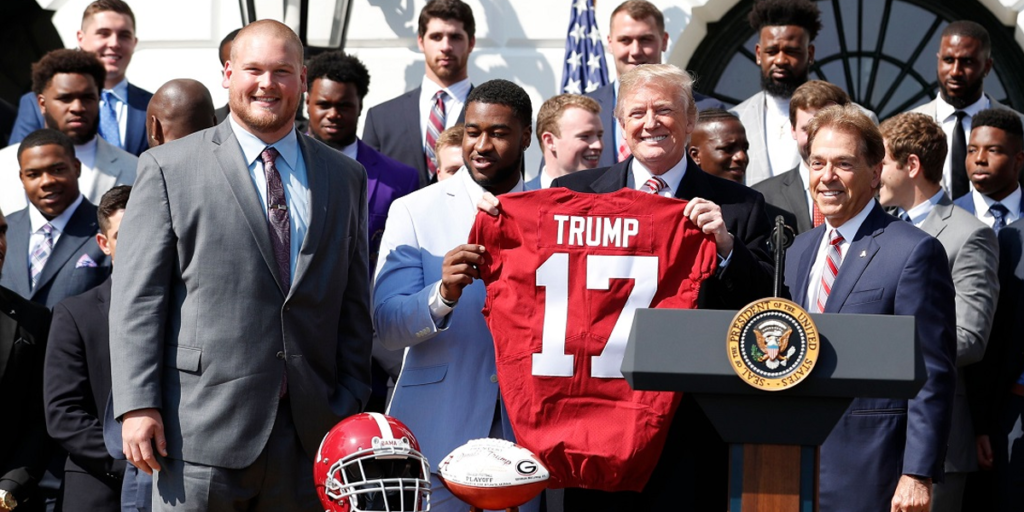
President Donald Trump welcomed the University of Alabama’s national championship football team to the White HouseTuesday with a ceremony on the South Lawn. Coach Nick Saban and the team presented President Trump with an Alabama jersey, helmet and a game ball from the College Football Playoff National Championship Game during the ceremony. The visit also included a tour of the White House, including the East Room, State Dining Room, Red Room, Blue Room and Green Room. The trip to the White House was the Crimson Tide’s fifth since the spring of 2010. This visit recognized the Tide’s 26-23 come-from-behind overtime victory over Georgia in the 2018 CFP National Championship Game in Atlanta. It was Alabama’s 17th claimed national championship and the fifth under Nick Saban. Republished with permission from the Alabama NewsCenter.
Crimson Tide in the college football playoffs; Auburn faces another unbeaten in Peach Bowl
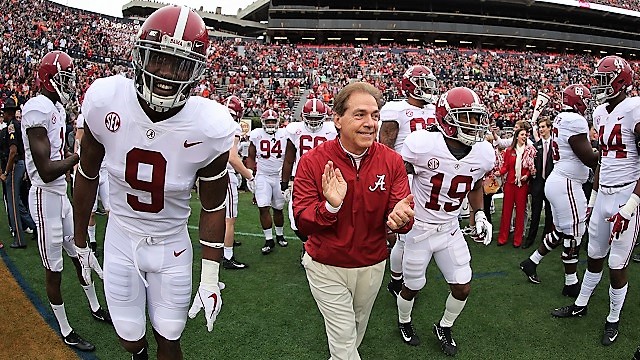
A really imaginative tweet went out Saturday night. “With the noon (Eastern) time college football playoff show, will there even be church services in Alabama, or just all morning prayer vigils? Houndstooth blazers required.” With the noon time college football playoff show, will there even be church services in Alabama, or just all morning prayer vigils? Houndstooth blazers required. — drgraves-UGA Adm. (@drgravesUGA) December 3, 2017 Those prayers of Crimson Tide fans were answered Sunday morning as Alabama was awarded the fourth and final slot in the college football playoffs. Coach Nick Saban’s squad will face CFP No. 1-ranked Clemson in a national semifinal at 7:45 p.m. CST on New Year’s Day in the Allstate Sugar Bowl at the Mercedes-Benz Superdome in New Orleans. “Dabo (Swinney) has done a fantastic job with that program,” Saban said of the Clemson coach. “They’ve been consistently successful and this will be the third year we’ve played them in the playoff. I know our guys will be ready to play and will have a tremendous amount of respect for Clemson. We’ll have to play our best game of the year to have a chance to be successful against them.” The No. 2 Oklahoma Sooners and No. 3 Georgia Bulldogs will play in the other semifinal game at the Rose Bowl in Pasadena, California, at 4 p.m. in the Rose Bowl. Georgia punched its ticket into the playoffs by beating Auburn 28-7 in a rematch of the Tigers’ 40-17 victory three weeks prior. The national championship game is at 7 p.m. on Jan. 8 in Atlanta’s Mercedes-Benz Stadium. All three games are on ESPN. Alabama Athletic Communications reported Sunday that Tide Pride members have until 5 p.m. on Monday, Dec. 4, to submit requests for playoff semifinal and championship game tickets. Each participating school will receive 13,000 tickets for the semifinal and 20,000 tickets to the championship. Other than the tickets allotted to the schools, the game is sold out. All requests made by University of Alabama constituency groups (Tide Pride, lettermen and faculty/staff) will be evaluated for all games following the request deadline. For the Allstate Sugar Bowl, all confirmed ticket requests will be shipped to customers via UPS, with a planned shipment date of Friday, Dec. 15. For the championship game in Atlanta, all confirmed requests are planned to be sent via mobile ticket (email and Ticketmaster app download) delivery with a planned send date of Thursday, Jan. 4. Ticket prices are as follows: semifinal Allstate Sugar Bowl: $275 club and $175 reserved; national championship: $675 (club), $575 (100- and 200-level seats) and $475 (300-level seats). The ability to request tickets does not guarantee tickets. If demand is greater than the allotment of tickets received, refunds will be given based on Tide Totals priority points. Lettermen should note that, if requests received exceed the lettermen allotment, requests will be filled based on last year lettered. UA faculty/staff should note that, if requests received exceed the faculty/staff allotment, requests will be filled based on years of service. “We’re extremely pleased for our team, our players, our coaches and all the people who work hard here for us,” Saban said. “I’d like to congratulate the other teams that will have the opportunity to participate in the playoff as well as the teams who were considered and had potential to be selected. We are really pleased and happy to be a part of the college football playoff again this year.” Since its inception in 2014, Alabama is the only team to appear in all four playoffs, and has appeared in the top five of every poll put out by the selection committee over the past four seasons. The Crimson Tide and Clemson will meet for the 18th time in the history of the series that dates back to 1900. Alabama owns the series advantage, 13-4. The two most recent matchups came in the 2016 and 2017 national championship games. Alabama rallied to defeat the No. 1 Tigers, 45-40, to capture the Tide’s 16th national championship in the 2016 game in Glendale, Arizona. The Tigers returned the favor with a come-from-behind 35-31 win in the 2017 championship in Tampa, Florida. No. 7 Auburn faces American Athletic Conference Champion and CFP No. 12 Central Florida in the Chick-fil-A Peach Bowl’s 50th anniversary game. That contest is set for the Mercedes-Benz Stadium in Atlanta and will be nationally televised by ESPN at 11:30 a.m. UCF is making its first trip to the Chick-fil-A Peach Bowl, while Auburn will make its sixth appearance. Auburn has a 4-1 record in the game, with its most recent appearance resulting in a 43-24 victory over Virginia in 2011. “We couldn’t have asked for a better matchup to celebrate our 50th anniversary,” said Gary Stokan, Chick-fil-A Peach Bowl CEO and president. “To have college football’s only undefeated team square off against the first-ever team to defeat two College Football Playoff No. 1-ranked teams in a season makes for an extremely compelling game.” Auburn’s Gus Malzahn will coach in the bowl game with a new contract. He has agreed to a seven-year deal to remain at the school after a strong late-season rebound, The Associated Press reported on Sunday. Complete financial details were not immediately available but the AP reported Malzahn will make more than $7 million in the final year of the contract. Other Southeastern Conference teams headed to bowl games are: Citrus Bowl presented by Overton (Orlando) – LSU vs. Notre Dame at noon on Jan. 1 on ABC. Academy Sports & Outdoors Texas Bowl (Houston): Missouri vs. Texas at 8 p.m. Dec. 27 on ESPN. Belk Bowl (Charlotte): Texas A&M vs. Wake Forest at noon on Dec. 29 on ESPN. Franklin American Mortgage Music City Bowl (Nashville): Kentucky vs. CFP No. 20-ranked Northwestern at 3:30 p.m. on Dec. 29 on ESPN TaxSlayer Bowl (Jacksonville): Mississippi State vs. Louisville at 11 a.m. on Dec. 30 on ESPN. Outback Bowl (Tampa): South Carolina vs. Michigan at 11 a.m. on Jan. 1 on ABC. UAB got a jump on Selection Sunday. The Blazers released their postseason plans last week, announcing that they’ll play Ohio in the Bahamas Bowl at 11:30 a.m. on Friday, Dec. 22 on ESPN. In other state-connected bowls: R+L Carriers New Orleans Bowl: Troy is the other state team that is

